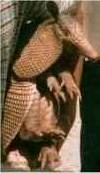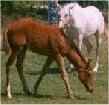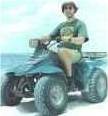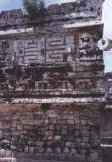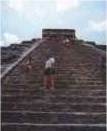Valladolid
|
|
|
| A pretty
little town with a very big church and a well tended square in the
centre but both are marred by horrendous concrete madonnas and Christs. |
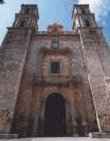 |
Rio Lagartos
|
|
| A large,
protected, lagoon area where wildlife and boat drivers alike thrive
on the tourist industry. I suspect the boat drivers are doing better
at it than the wildlife as the technique to make the wildlife look
lively and attractive was simply to drive straight at any quiet animals
until the ran / swam or flew away. |
 |
The flamingoes
were fabulous, merely pale pink when wading in the sandy, blue water
but intense, almost flourscent pink showing under their wings when
flying |
 |
 |
 |
| The colour
contrasts were spectacular - that deep blue sky with white streaks
of cloud, washed out white of sand with sandy blue water, vibrant
green, mangroves in the waters' edge and vivid red salt 'farms' on
the seaward side |
| This poor
alligator was basking quietly in the sun until out of nowhere our
boat and two others starting jostling to get their charges closest
for photos, the alligator soon retreated and one of the boats grounded
itself |
 |
Balankamche
|
|
|
| Set in an interesting,
tropical jungle, botanical garden are the caves of Balamkanche and
our second sound and light show. 5 out of 7 people had slept at least
part way through the first back at Chichen but no such luck here. |
 |
| The cave system is one
way, about a kilometre from start to finish and no a single puff of
fresh air all the way. Sweat was pouring off everyone by the end as
we dealt with the strain of walking, even such a short distance with
no fresh air, that air had been breathed for centuries by the Mayan
people and was just about good enough for us too |
Izamal
|
|
|
 |
The largest atrium in
Latin America. Now don't get too excited folks. This is an impressive
nunnnery because of its size and the way it utterly dominates the
surrounding town |
| It's all built on the
base of and from the stones of a large pyramid and it's not entirely
surprising that it's big. The pyramid was reported by the Spaniards
to be so large that they could see the sea from the top |
 |
| The sea is 80 km away |
 |
 |
Merida
|
|
|
| Merida is a modern university
town reputed to have more millionaires per head of population than
anywhere else in the world. Most of that money was made on the back
of the sizel industry which although still active and generating incomes
for many farmers is a failing industry what with modern materials
like nylon. |
In the town
centre there are tourist police whose job it was to look after tourists and nothing else. So this stunning structure (modern) situated on
a roundabout in the middle of a main road was no problem to reach
with the help of tourist police to stand in front of the traffic for
you
and nothing else. So this stunning structure (modern) situated on
a roundabout in the middle of a main road was no problem to reach
with the help of tourist police to stand in front of the traffic for
you |
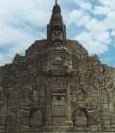 |
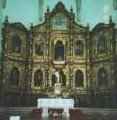 Merida
was once a small town, unlike the large town of Merida in Guatemala.
Somehow the plans for the local church for either town got mixed up
and the Guatemalans ended up with a tiddly chapel for a large population
whilst the Meridans got a full blown cathedral which only recently
have they grown into. Merida
was once a small town, unlike the large town of Merida in Guatemala.
Somehow the plans for the local church for either town got mixed up
and the Guatemalans ended up with a tiddly chapel for a large population
whilst the Meridans got a full blown cathedral which only recently
have they grown into. |
| Lorna and
Holly, all museumed out |
 |
Uxmal
|
|
|
| This is a much smaller
site than Chichen with less restoration having taken place so far
and many more buildings packed into this smaller area |
| With the air of unrestored wildness
and lack of tourist hordes Uxmal had a magical quality |
 |
 |
 |
The Magician's Pyramid,
rebuilt from a pile of rubble but originally added to for over 400
years. |
| The Nunnery Quadrangle
so named because the small rooms reminded the Spaniards of a nunnery.
The face of this building is covered is elaborate carvings of Chac |
 |
 |
The Dovecote has an unusual
roof comb on top of numerous 'cells' believed to be small family homes |
 |
 |
The two headed jaguar throne was
the traditional seat of rule. This is the last one because the Spaniards
struck a head off any they found to dissolve the ruler's power |
 |
 |
The Governor's Palace,
a long imposing structure on top of a small man made plateau |
 |
 |
 |
Labna
|
|
|
| Again, on the Puuc Route
another small town with a large stone arch which was just a part of
a building between two courtyards. Unfortunately, that photo was rubbish! |
 |
Sayil
|
|
|
| Once more
on the Puuc Route another small town with evidence of surrounding
villages. The main feature though is this 3 tier palace with many
rooms. |
 |
| It took a
quite a while before anyone suggested to the Mayans that buildings
could exist on more than one floor |
Each tier
is a different architectural style and time period. |
|








 and nothing else. So this stunning structure (modern) situated on
a roundabout in the middle of a main road was no problem to reach
with the help of tourist police to stand in front of the traffic for
you
and nothing else. So this stunning structure (modern) situated on
a roundabout in the middle of a main road was no problem to reach
with the help of tourist police to stand in front of the traffic for
you 
 Merida
was once a small town, unlike the large town of Merida in Guatemala.
Somehow the plans for the local church for either town got mixed up
and the Guatemalans ended up with a tiddly chapel for a large population
whilst the Meridans got a full blown cathedral which only recently
have they grown into.
Merida
was once a small town, unlike the large town of Merida in Guatemala.
Somehow the plans for the local church for either town got mixed up
and the Guatemalans ended up with a tiddly chapel for a large population
whilst the Meridans got a full blown cathedral which only recently
have they grown into.














